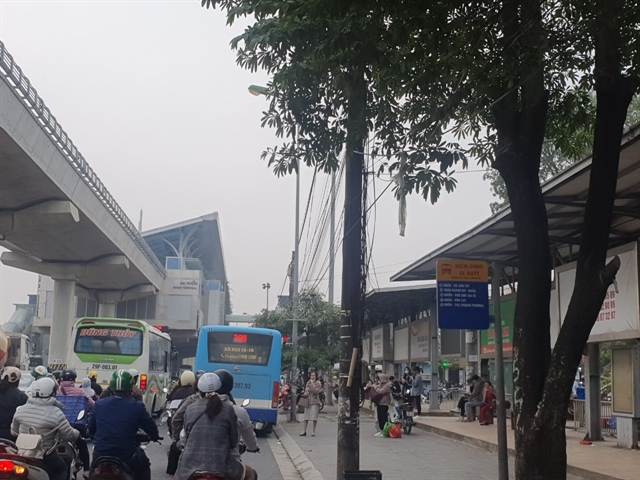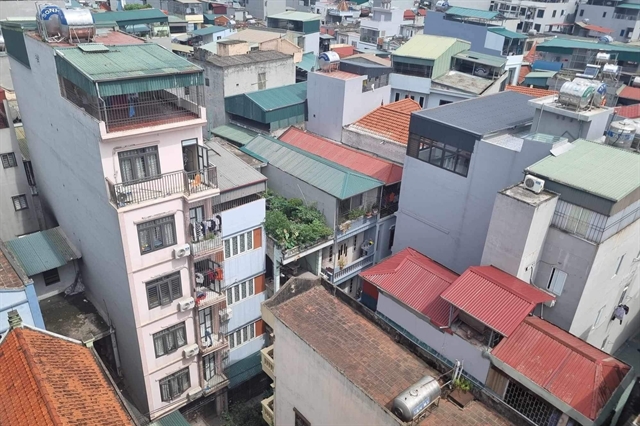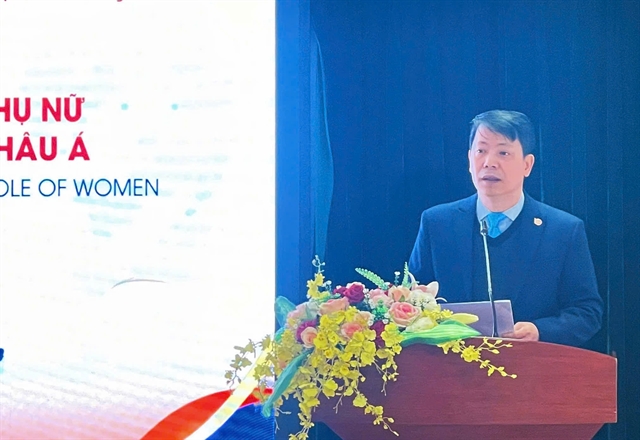 Society
Society


|
| Many stations on the Nhổn–Cầu Giấy elevated urban railway line lack links with other public transport means. — Photo laodong.vn |
HÀ NỘI — The Nhổn–Cầu Giấy railway line, an elevated section of Nhổn–Hà Nội Railway Station route, is set to commence operations in the third quarter of 2023. However, according to recent reports, many stops along the line will not be linked to any bus stations for onward travel.
The National University and Lê Đức Thọ stops are not near bus stops, meaning passengers will have to walk back to Xuân Thuỷ Street and Hồ Tùng Mậu Street to catch a bus.
At Minh Khai station, the situation is worse, and passengers will have to call a taxi for the rest of their journey. The same story is repeated at the Cầu Diễn, Phú Diễn, and Nhổn stations.
Vũ Anh Tuấn, director of the Việt Nam-Germany Transport Research Centre at the Việt Nam-Germany University, has suggested that more bus stops be located near train stations along the metro line to attract passengers. He shared this in an interview with Giao thông (Transport) online newspaper.
The buses should connect residential areas with stations, he added.
It is necessary to draw experience in organising traffic and connecting with bus stops from the Cát Linh–Hà Đông urban railway line to make the necessary adjustments for the Nhổn–Cầu Giấy elevated urban railway line, he said.
More bus stops needed
Thái Hồ Phương, deputy director of the Hà Nội Public Transport Management Centre, said that there are currently 31 bus routes connecting to the Nhổn–Cầu Giấy elevated urban railway line.
He said that 28 of these routes are subsidised and three are not, serving an average daily of more than 118,000 passengers.
With the current status of bus infrastructure, bus stops along the Nhổn–Cầu Giấy elevated urban railway line will have to be re-arranged and supplemented to facilitate connection with the train stations, he said.
Phương also said an additional 12 bus routes would be connected to the Nhổn–Hà Nội Railway Station line, including nine new bus routes, bringing the total number of connect bus routes to 43.
After completing the connection between bus stops and train stations, the transport capacity of buses along the Nhổn–Hà Nội Railway Station line will improve.
The transport capacity of buses along the Nhổn–Cầu Giấy elevated urban railway line will increase three to four times compared to the current transport capacity, meeting about 30-50 per cent of the total travel demand of passengers.
The Hà Nội Public Transport Management Centre said, at first, it is forecasted that about 15-20 per cent of people living along the route will switch from using personal vehicles to the urban railway line's metro.
Moreover, the number of taxis operating along the route will also decrease because people will use the metro thanks to low costs, reducing travel time and traffic congestion.
Trần Hữu Bảo, deputy director of the Hà Nội Transport Department, said the department had studied traffic organisation to serve when the Nhổn – Cầu Giấy elevated urban railway line comes into operation.
In addition to buses, he said there would be two-wheel electric vehicles, tech-based motorbike taxis, and tech-based taxis to serve train passengers when they get off at the train stations.
He said the road sign system would also be installed when the Nhổn–Cầu Giấy elevated urban railway line operates.
Smooth trial runs

|
| A train during the test run at the Nhổn–Cầu Giấy elevated urban railway line in December 2022. — VNA/VNS Photo Hoàng Hiếu |
Since December 5, 2022, the Hà Nội Metropolitan Railway Management Board (MRB), together with contractors and consultants, have tested the elevated section of the railway line.
Following the technical design of the urban railway line, each train consists of four carriages capable of carrying 230 passengers.
After seven days of testing as of December 5, 2022, system availability reached 99.65 per cent, and all tests passed.
The Nhổn-Hà Nội Railway Station line covers 12.5km with eight elevated stations and four underground.
The 1.17-billion-euro metro line will run through districts of Bắc Từ Liêm, Nam Từ Liêm, Cầu Giấy, Ba Đình, Đống Đa and Hoàn Kiếm.
The trains are expected to be operated at 35km per hour on average and 80km per hour maximum, the same speed as metros in Paris, Berlin and other cities in Asia. — VNS




